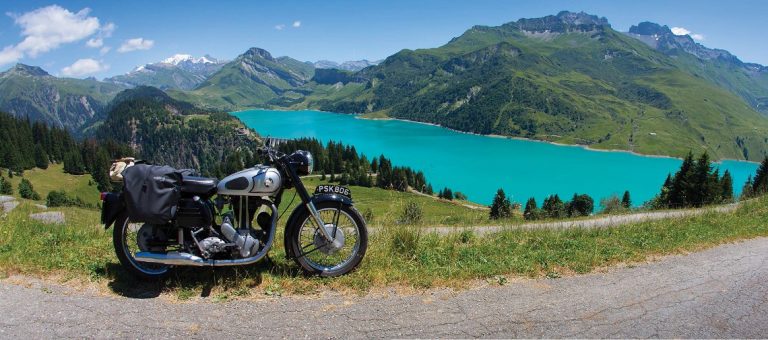In an effort to revisit the heritage of adventure motorcycling, John Norris heads off on a two day tour around Western Europe’s highest mountain, Mont Blanc, on a 1956 Norton 19S 600cc…
When do you think the history of the adventure motorcycle begins? Is it with the 1912 Henderson on which Carl Stearns Clancy rode around the world in 1912? That bike was a four-cylinder 7bhp machine with no front brake and one gear. It is unlikely, I am guessing, that the Puch 250 on which Max Reisch made the first bike trip from Europe to India in 1933- 34, is a prime contender.
I read once, somewhere, about two BSAs slogging across the Darien Gap quite a while before Helge Pedersen’s epic journey. The first English woman to circumnavigate the globe, Elspeth Beard, used a 1974 BMW R60/6, a sound choice of adventure bike I reckon. Though it’s not the model where my own ‘adventure bike history’ would begin.
No, for me the history I recognise begins with the re-invention of the big single, specifically the Yamaha XT 500. Once, after my usually dependable Yam RD 200 had broken down I was hitching home near Kirkby Lonsdale when, to my delight, a cheerful grey-bearded gent in an open face helmet picked me up on the recently released big XT. He was the editor of MCN at the time and I had a blast riding home as pillion on this ground-breaking machine. The XT had started in motion a chain of events and machines that would lead all the way to today’s amazing adventure motorcycles.
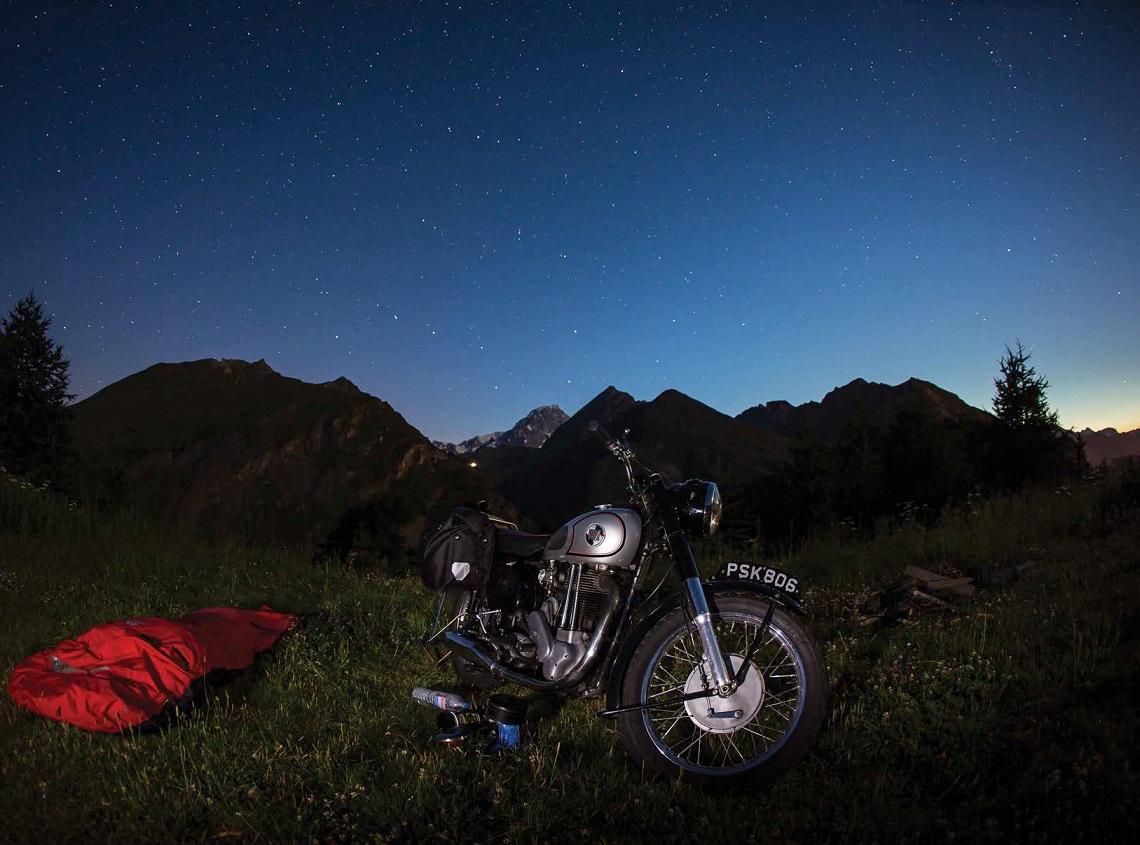
For a summer bike trip last year I rode a machine more akin to the bike Che Guevara called La Poderosa or ‘The Mighty One’, which, like my own, was a big Norton single. My version is a 600cc model manufactured over a decade later but essentially the same concept.
Now, why would someone who owns a very sound BMW 1100GS begin touring on a bike with limited power, even more limited brakes, a very hard seat and an engine that needs nurturing? Curiosity. I had always wondered what the original British bikes that arguably inspired these modern singles would be like to ride.
Last year I went to look at a 1956 Norton 19S 600cc single. The very minute the motor fired up I knew I had to have it. It is one of the longest stroke singles ever made and while speed is not its forte, it is a brute of a hill climber with a laid back nature and therefore made some kind of sense for life in the Alps where I lived.
At least, that was my rationale. I arranged to pick up the bike a few days later and then rode it from Haydon Bridge in Northumberland over Hartside and across to Windermere, a great first ride on any new machine.
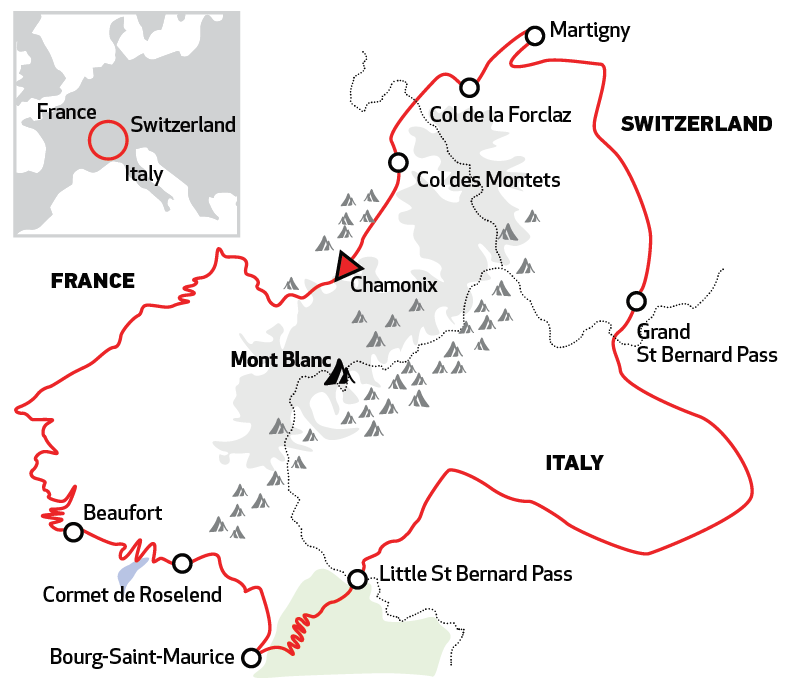
Once safely in my own shed, I took some time going over the electrics, sorting a coil problem, coating the inside of the tank against the ravages of ethanol fuel and generally setting the bike up for a trip.
To really get to know my new bike I thought I would try a challenging but fairly short ride of a couple of days with an overnight in the great outdoors. From my home in the heart of the Alps, I did not need to travel far so what better challenge for a bike with celebrated hill-climbing grunt than a mountainous circumnavigation of Western Europe’s highest mountain, Mont Blanc? A testing 200 miles of steep cols and hairpins, through the stunning Alpine scenery of three countries; France, Italy and Switzerland, all on a 59-year-old motorcycle.
We were having a heat-wave in France so I waited for a forecast of slightly cooler weather and clear skies to minimise the chances of the motor overheating on the long alpine climbs.
I left in the cool of the early morning, riding down the Chamonix Valley with the great summit of Mont Blanc rising up behind the jagged Chamonix Aiguilles. As the engine warmed up and smoothed out it inspired me with cautious optimism.
The morning sun was casting long shadows over Alpine meadows on the approach to Col de Saisies in the Haute Savoie, while the sound of my bike’s staccato exhaust note ricocheted off low granite walls beside the hairpins. My throw over panniers were loaded with a bivvy bag, sleeping bag, stove, down jacket and a camera along with some minimal food supplies. I also had a canvas bag with waterproofs and a generous stash of tools of strange sizes like 5/16ths and 1/4 inch Whitworth. This really was unknown territory.
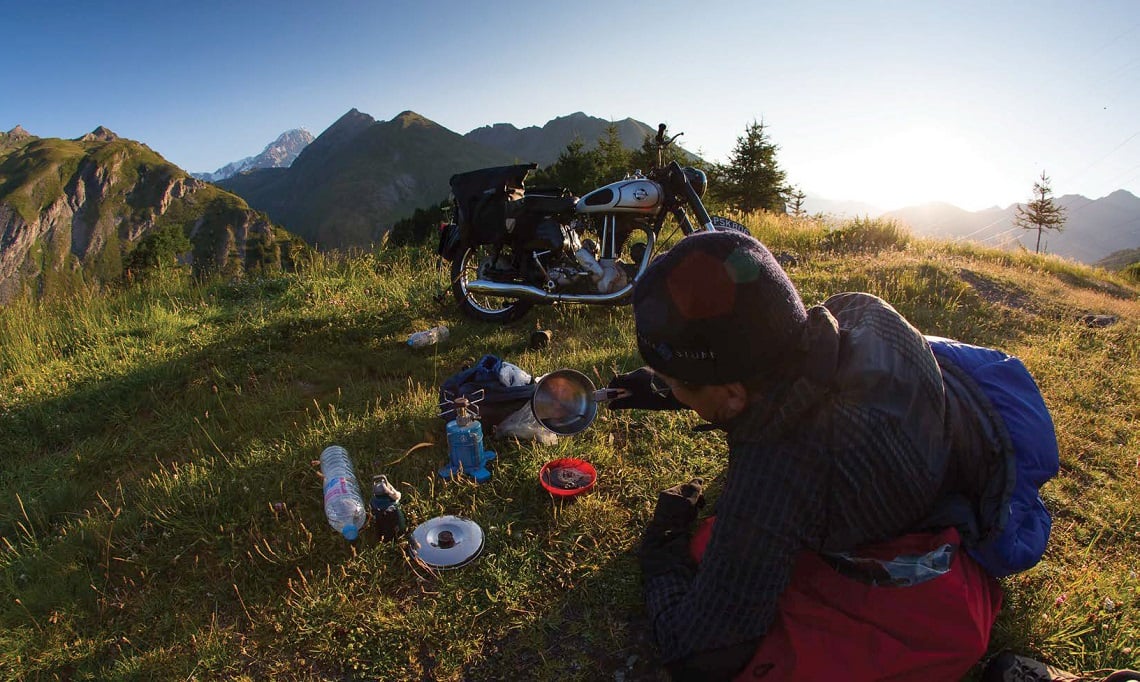
After a mellow coffee and croissant break in the pretty village of Beaufort, I chose a tiny back road that wound through hamlets and farmland but soon began to climb steeply. The Norton gear change was as counter-intuitive for me as the kids trick of patting your head and rubbing your stomach in circular motion!
After nearly four decades of riding left-hand gear changes, I was adapting to both a right-hand gear lever and a ‘one-up three-down’ box. I had visions of heading towards an alpine precipice and instead of slowing down completely missing the feeble brake and instead changing into top for a rapid airborne descent to the rocks below.
It was also quite hard to choose the right gear to deal smoothly with these tight bends and the steep exits out of them because the four ratios were so widely spaced, but that was all part of the fun. When I needed to I simply sat patiently in a lower gear at slightly higher revs until a more level stretch permitted changing up.
At the summit of the Cormet de Roseland, I paused for a break so I could warm up while the bike cooled down. At 1,967m this may not be the highest col in the Alps, but it is certainly one of the more scenic ones.
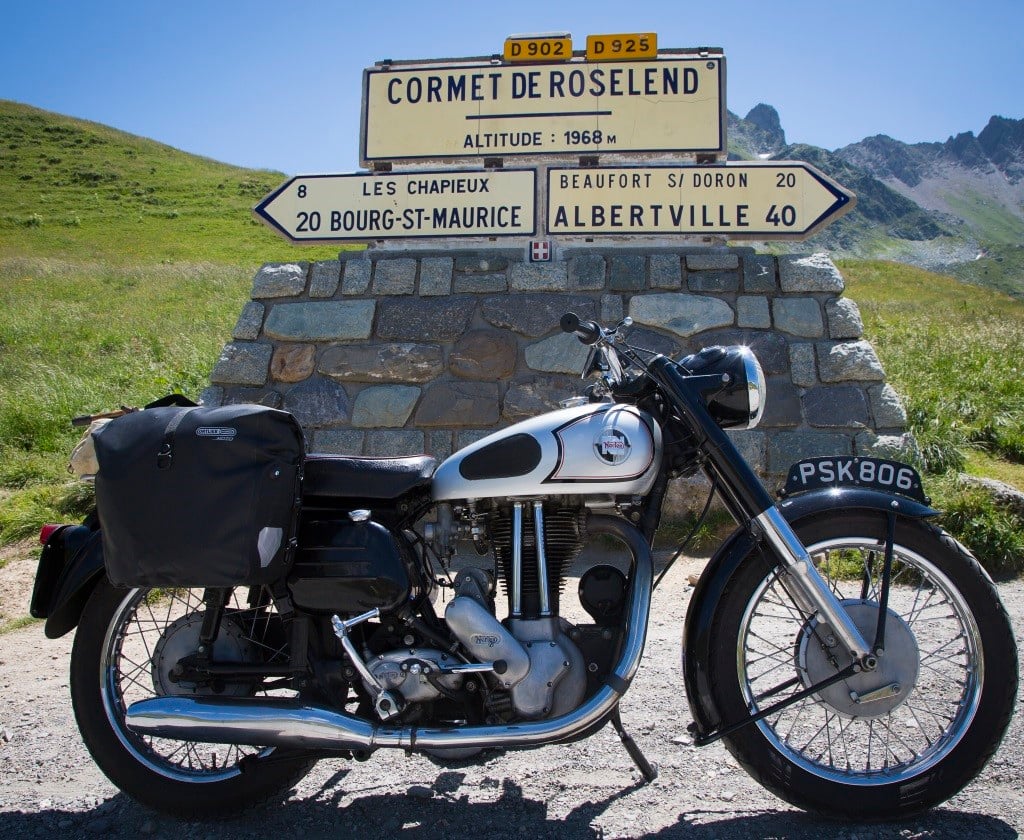
Fortunately, the weather was fabulous, amazingly clear air, stunning blue skies and no wind. It was a long, winding and very scenic descent to the next valley. It begins with wide sweeping curves before dropping into tight, steep and narrow hairpins through woodland and finishes by crossing terraced fields above Bourg St Maurice. The single leading shoe drum brakes that are already pretty inadequate were, on these epic alpine descents, quite entertaining. The huge drops and lack of barriers certainly focus the mind and you quickly forget about such trivial things as vibrations or hard seats.
Luckily, the 19S does have superb engine braking so I made good use of that asset combined with alternate use of front and back brakes as needed to slow things down prior to hairpins. Remarkably this worked OK and I had no overheating, fading or near misses.
The altitude didn’t cause problems either despite the Amal carb being well above its maker’s specified altitude tolerance of 900m above sea level (on the standard jet/needle set up). OK, the bike did pop and bang pretty loudly on the over-run but this did an excellent job of clearing sheep, cattle and scavenging birds from the road ahead.
Traffic in the valley floor, as I traversed the few miles through Bourg St Maurice, was relatively heavy and the bike grumbled at all the stop-start. I found a petrol station, filled up and checked the engine oil level. Reassuringly I found the Norton had used almost no oil since departure. With a full tank and a fresh baguette for supper now bungeed to the rack, I began the climb to La Rosière, a seemingly endless back and forth on wide-open hairpins.
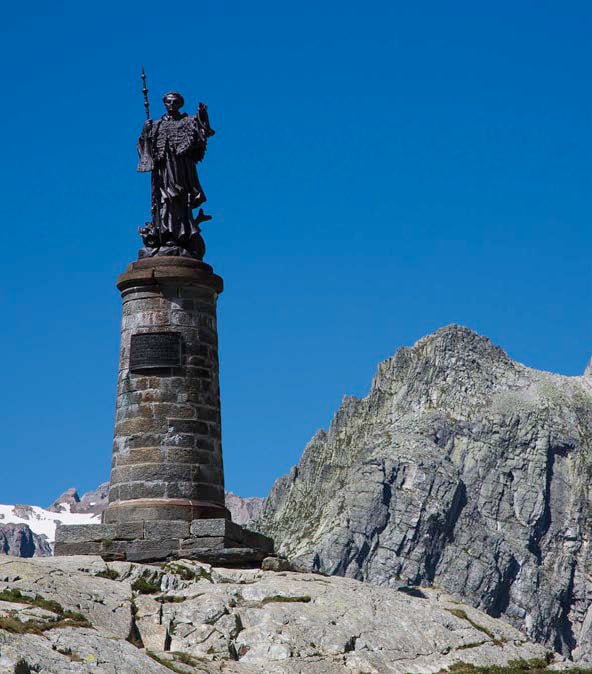
Here you climb on gradients of up to 8% from the stifling valley heat up to the cool air of the snow-capped mountains. The top of the Petit St Bernard is 2,188m and as you are now entering Italy this means an obligatory coffee stop given that the quality always takes a noticeable step up when served by Italians. There were lots of other riders around, although not surprisingly most were on modern adventure machines.
The sun was now low in the sky and I wanted to savour being up high in the mountain scenery, so I decided to look around for a secluded bivvy spot near the pass. A couple of miles away from the cafés and gift shops of the frontier I discovered a little stoney track that led away from the road through a jumble of rocks. When there was no one around I pointed the Norton off the tarmac for a bit of green laning. The track brought me to a flat grassy clearing well away from the road with stunning mountain views. Perfect.
As the bike quietly ticked, cooling down in the chill of the evening I sat and enjoyed views across to the great mountain I was circumnavigating. The southern flanks of Mont Blanc are even more dramatic than those on the French side and were perfectly framed between lower foreground hills. That night, while I put a brew on and made supper, a shepherd across the valley was calling out to his dog and the cowbells did their bit to complete the atmosphere.
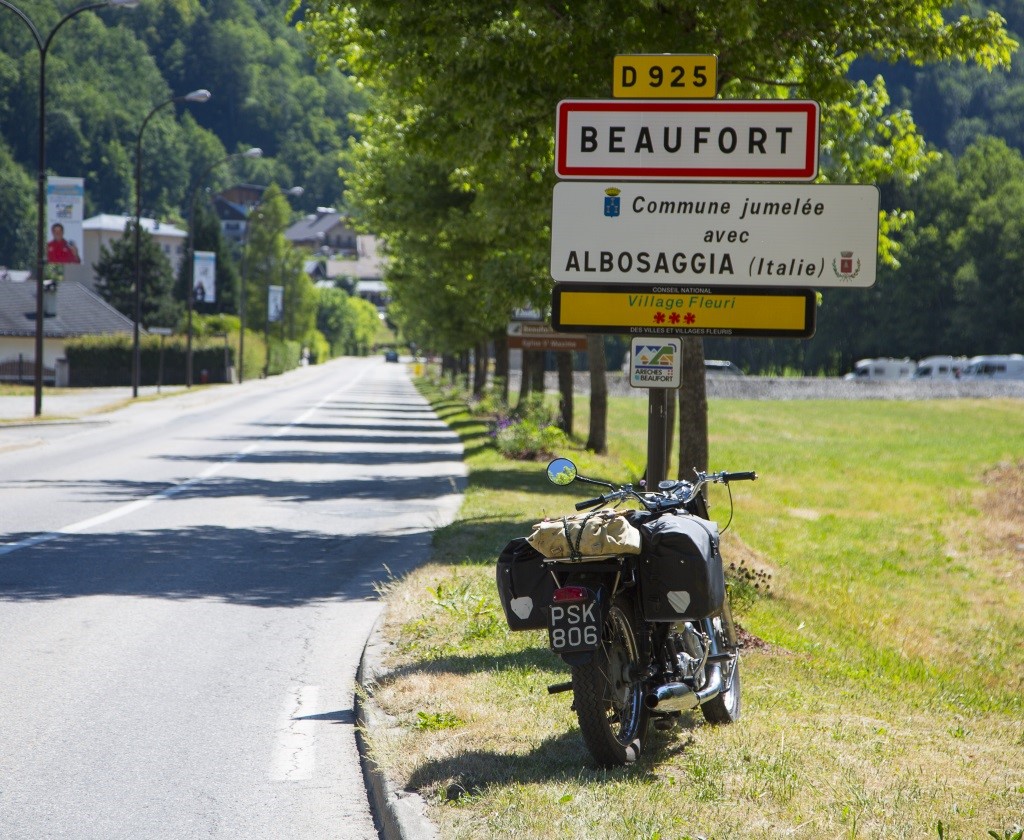
Later, as I lay in my bivvy bag I gazed for ages up at the spectacular night sky, unpolluted by any light from the valleys. The polished alloy and metallic silver of the Norton gleamed just a few feet away and I admit I may have cast an occasional admiring glance that way before falling soundly asleep exhausted from the day’s ride.
In the early morning, despite it being July, there was a surprise frost coating my bivvy bag and scattered possessions. Soon, the sun rose above the hills melting it and warming me as I started to pack up.
I had the descent to myself, the big motor running sweetly in the cool damp morning air and popping back nicely whenever I rolled off the throttle.
The classic climb of the trip and also the highest is the Grand St Bernard Pass at 2,469m. Famed as the dramatic road in The Italian Job it is a real mecca for bikers of all genres and you will often see older classics taking on the challenge. At one point I passed a guy on a BMW R26 250cc single of similar vintage to my bike. He was two up and climbing slowly but with a huge smile on his face.
Further up the pass, while I paused to take a photo, a big group of 70’s classics swept by. They obviously approved of the Norton as I was given a series of toots on the horns and thumbs up.
Norton 19S 600cc single cylinder.
Registered in 1956 and now with an unconfirmed 79,000 miles on the clock.
————————————————————–
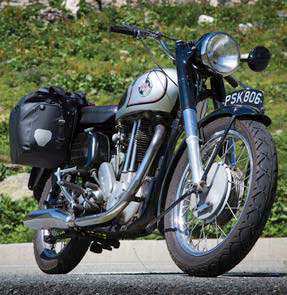
Reaching the top of the pass on my old Norton was a hugely satisfying moment. It is such an epic and beautiful road with a wealth of history stretching back through the centuries.
While I sat enjoying the sunshine outside a café quite a few folk wandered up for a closer look at the bike. They are often surprised when you tell them it is a 600cc as it is so physically small compared to today’s machines. I checked the oil level and looked the bike over before beginning the very long descent down to Martigny in Switzerland.
I still had two more passes to climb, the Col de la Forclaz and the Col des Montets, before finishing my Tour du Mont Blanc back in Chamonix, but the bike was on a roll and the biggest challenges were now behind us. In a few hours from here, I’d be home reflecting on two brilliant days of riding over a glass of homebrew.
If an adventure is a journey where you can’t predict the outcome then an old bike will often deliver that element of uncertainty and some surprises both good and bad.
You are unlikely to get speeding tickets but you are likely to slow right down and enjoy the views. You’re also forced to plan on a much smaller scale rather than being tempted to cram too much into your itinerary.
Lastly, without the reassuring 10,000 mile-plus service intervals of today’s machines there is huge satisfaction in reconnecting with the mechanics of the bike you are riding. You are aware of every rattle, tap and vibration. You neglect the machine at your peril.
Having clocked up well over 1000 miles this summer on the Norton I can safely say I won’t ever be thrashing down for a two-week break in Morocco on it in the way I might consider on my faithful GS. That said, I do plan to do more trips on the big single. Maybe Scotland or Ireland, maybe Northern France, but I think I will need a different category for it. Let’s say it can be my ‘micro-adventure’ motorcycle.
Want to ride the Tour du Mont Blanc?
When to ride the TMB
Any time between June and October can be fine but in high summer (mid-July to end of August) it will be much busier.
What to carry and what to expect
Huge temperature variations from the valley floors to the tops of cols and storms can bring snow even in midsummer. Make sure you take layers for flexibility. I used a Mountain Equipment GoreTex bivvy bag, down jacket and sleeping bag. Ortleib panniers were an easy luggage solution for the Norton. On the bike a ventilated jacket with a wear-under windproof for the early starts was fine.
Because the roads are demanding and often narrow, thorough preparation of the bike beforehand is advisable. Check for worn wheel bearings, etc. and brake pad wear and of course, check brake fluid levels (or cables). Good tyres are a must although you might notice I had a ‘square death’ on the back because I can’t bear to throw it out.
Accommodation
Either camp wild or there are official campsites in or near all the towns en route. There are also lots of gites, hotels and mountain refuges along the way including at the Grand St Bernard Pass. In Chamonix, the Hotel Pointe Isabelle (www.pointeisabelle.com) is stylish and newly refurbished if you want to be in the town centre or in the village of Argentiere further up the valley at the cheaper end and often with bikes parked outside are the Randonneurs (www.lesrandonneurs.fr) and Belvedere (www.gitelebelvedere.co.uk).
Where to start/which way around
Anywhere on the circuit but the Chamonix Valley does make a very scenic place to prepare and then wind down post-trip. I favoured the anticlockwise route because it meant I did the only really major road early in the morning and downhill, an advantage on the Norton.
Getting there
Either ride from Santander and take in this trip on a loop through the Pyrenees and Alps back towards the UK or a two to three-day ride from Calais will get you comfortably to Chamonix on the back roads.
If you want to start or finish your alpine trip in Chamonix contact www.philwhitefrieght.com who runs transport between the UK and Chamonix fairly regularly through summer and will take excellent care of your pride ‘n joy!

